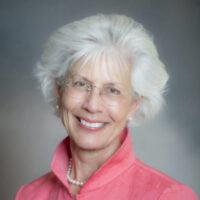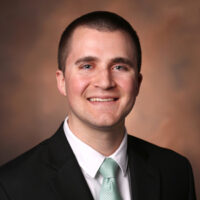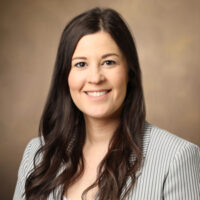Thomas Scott, who is legally blind and lives alone, had trouble getting around his home. Navigating stairs was difficult, and the lighting in his home wasn’t ideal. To make matters worse, the 73-year-old southeast Nashville man doesn’t have the best balance.
But thanks to a collaborative effort and pilot program between Salus University’s Blindness and Low Vision Studies department, Vanderbilt Eye Institute (VEI) and Vanderbilt Home Care Services (VHCS), Scott is able to navigate his home environment much easier these days. Salus University, located near Philadelphia, offers degrees for several health disciplines, including Orientation and Mobility (O&M), the ability for individuals experiencing vision loss to travel safely and independently in their environment.
The pilot program trains physical therapists (PTs) at VUMC to provide O&M skills-based training for patients with low vision.
Vanderbilt PTs trained in the program helped by adding reflective tape to Scott’s stairs so he can better see them while navigating. “It’s helped immensely,” he said. “I can see the steps more clearly.” They also suggested that he have grab bars installed on the staircase, making it much easier to go up and down the stairs.
And the team implemented a medication bubble pack with his pharmacy so he can take his medications consistently on his own. They are preloaded by the time of day, and he can take them all at once from the pack instead of having to decipher what’s in each bottle of pills.
A physical therapist also worked with Scott to improve his balance. Because of his impaired vision and a prosthesis, he was falling a lot. Now he falls less frequently and feels more confident walking around his home. “My balance is so much better. They showed me exercises where I stand and sit, sit and stand for a moment without any aid. I feel more comfortable and at ease,” Scott said. “I don’t worry about falls as much.”
He also now uses daylight LED bulbs which are brighter and make a big difference in navigating his home.
“They also have helped me with my patience, taking my time. I just want to get from point A to point B as soon as possible.”
There is a shortage of O&M instructors so the idea of the partnership was to provide skills-based training on selected indoor O&M skills for physical therapists who are often the first rehabilitation professional to meet with a person who has been diagnosed with low vision.
The first eight-week session began last summer and combined online and in-person instruction. Instructors from Salus traveled to Nashville to provide two days of hands-on training to seven Vanderbilt physical therapists who received a micro-credential, a certificate and PT continuing education credits for their participation. Another class of students is expected to begin later this year.

Those instrumental in the VUMC training were Joshua Robinson, OD, assistant professor of Clinical Ophthalmology, and Mary Beth Swain, PT, DPT, manager of Rehabilitation Services for VHCS. The idea for the partnership came from VEI board member Carlene Lebous, who through her experience in both rehabilitation and health care areas realized there was a tremendous gap between health care providers and the awareness of and referral for vision rehabilitation services nationwide. She and Robinson began talking about how to expand O&M services.
“My entire patient base is those with medically irreversible vision loss of different degrees and from different etiologies,” Robinson said. “Many would benefit from O&M training and from working with a certified specialist who provides people who have lost vision with strategies to first orient themselves and then be independently mobile in both familiar and unfamiliar environments.

“But there’s a shortage of certified O&M specialists to whom I can refer,” Robinson said. “So, typically there’s a backlog if we make referrals and long waits for patients to get training when it would really benefit them.”
Robinson said the new program is a start toward getting timelier O&M training services to the patients who really need them.
“At this time, the program is limited to those who meet homebound criteria,” he said. “But this means I can send a referral and at least have an introductory training scheduled with a patient within a couple of days. This is huge because vision impairment leads to increased fall risk and an increase of other mishaps in ambulation or injuries, and in some cases the inability to locate a dropped object, which is profoundly limiting.”

Swain said O&M treatments work to improve patients’ independence and safety at home, which is the overall goal of all patients receiving services through VHCS.
“But there are limited therapy options in the community for patients to receive specialized orientation and mobility treatment to help navigate a new diagnosis of low or no vision,” she said.
“Historically, O&M training for patients may not be covered through insurance. VHCS was already providing a billable skilled service to low vision patients, but it did not involve orientation and mobility. To bridge the gap for patients to receive O&M training in the home, Vanderbilt Home Care has select therapists who are now able to incorporate this training received from Salus University into the care plan for these patients that is very specific to the home environment.”
Lebous said nationwide O&M and other vision rehabilitation services have been delivered through state and social services agencies and private nonprofit entities, primarily because these specialists have trained in the colleges of education, not allied health, and these services are often not recognized as part of the health care delivery system. As a result, those who experience vision loss are often unaware that vision rehabilitation services are available.
“The lack of federal, state and private funding has resulted in a limited number of service providers and long wait times. This collaborative effort between VEI and Salus University to provide limited O&M training to physical therapists will help to deliver additional trained rehabilitation providers, raise awareness that such programs are available and allow for much needed referrals from health care providers, all of which should broadly improve the delivery of services to individuals experiencing low vision and severe vision loss.”
Robinson said the next step is to monitor outcomes of the patients using the new O&M services.
“An observer can clearly see this is providing a benefit, but if we can justify it with good evidence-based care, that will only further support growing the program to hopefully become a standard nationwide for how these cases are managed.”












